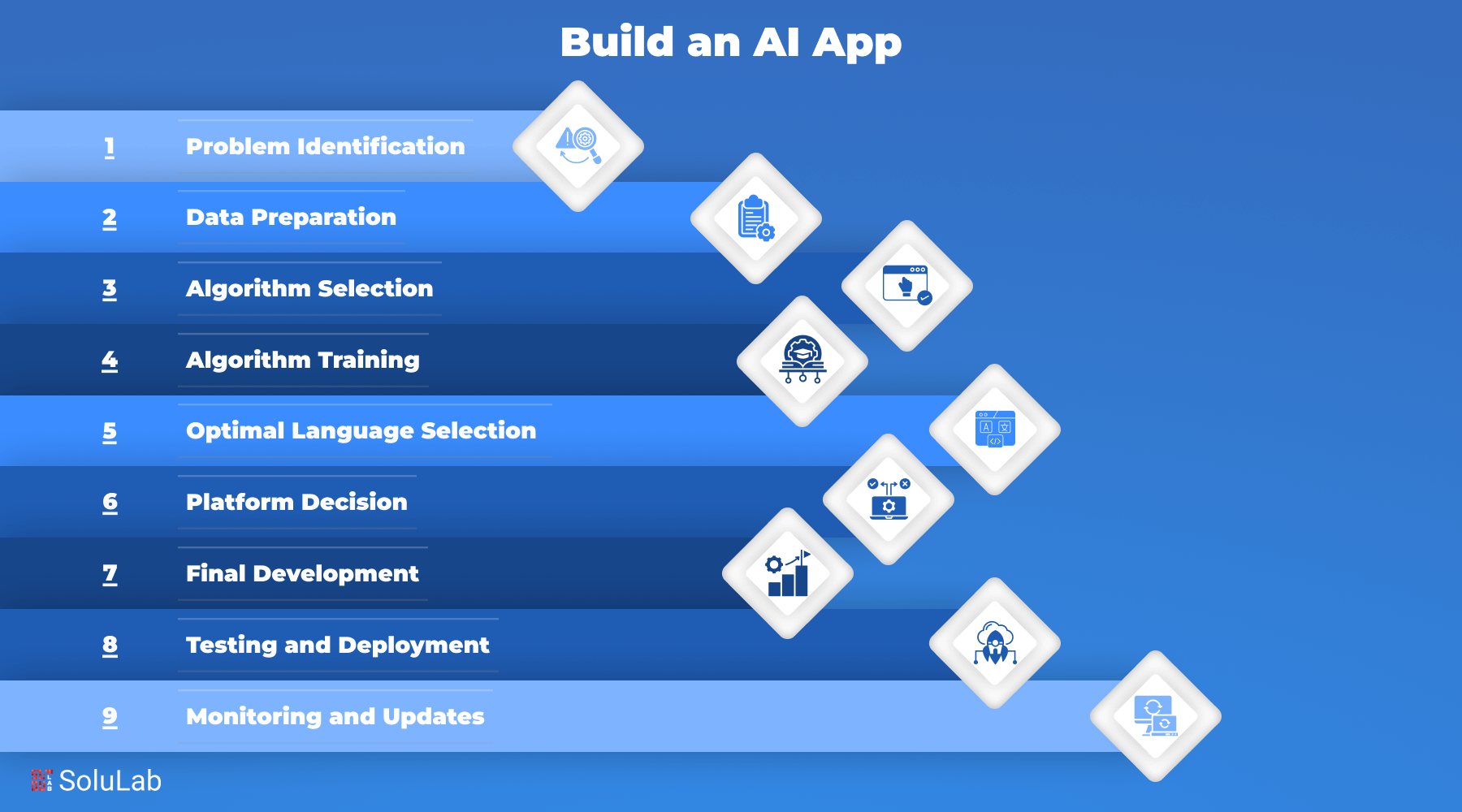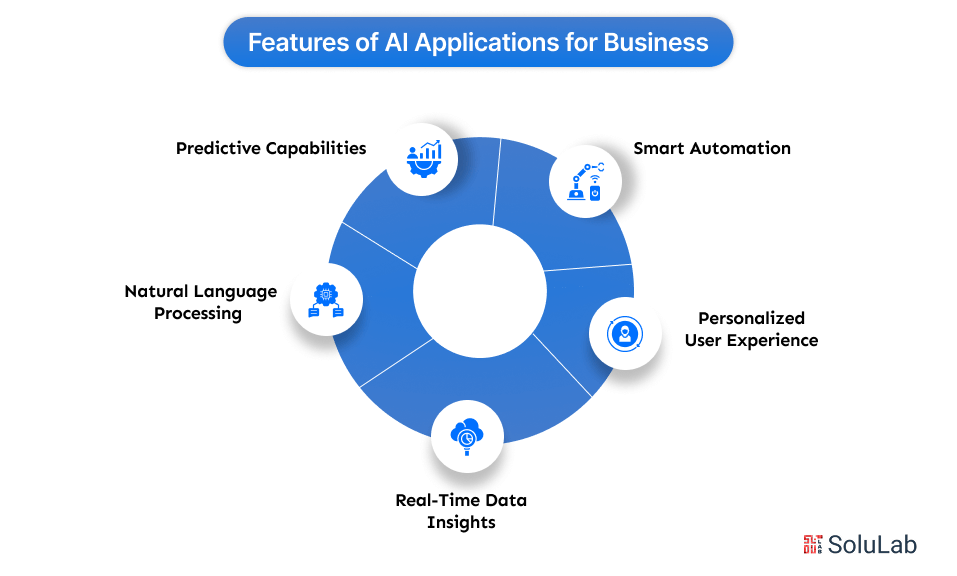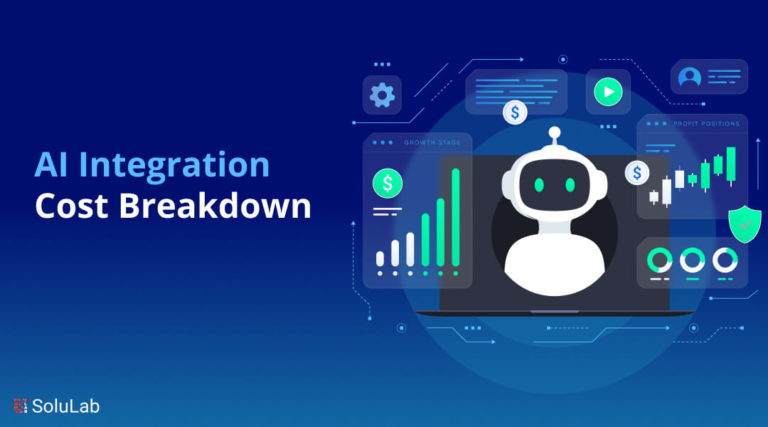
Ever wondered how to build your own AI app but don’t know where to start? With AI becoming a crucial component in every industry, from healthcare to finance to entertainment, it’s no surprise that everyone wants a piece of the action.
But here’s the thing: building an AI app isn’t just about writing fancy code or throwing around terms like machine learning and neural networks. It’s about solving real problems using smart technology.
In this step-by-step guide, we’re breaking it all down for you. Whether you’re a startup founder, a product manager, or just someone curious about AI, this blog will walk you through the entire process of creating an AI app from scratch.
From identifying the right use case to choosing your tech stack and testing your model, we’ve got you covered. Let’s begin!
What is an AI App?
An AI app is a software application that uses artificial intelligence to perform tasks that typically require human intelligence. These tasks can include understanding language, recognizing images, predicting outcomes, learning from data, and making decisions.
Here are some real-life examples of popular AI Apps:
- ChatGPT – Uses natural language processing to understand and reply like a human.
- Amazon & Flipkart – Show product recommendations using AI based on your browsing and buying habits.
- Grammarly – Uses AI to check grammar, tone, and suggest better writing.
Benefits of AI App Development for Businesses
Utilizing AI applications for your business can yield numerous advantages, enhancing customer service and bolstering brand trust. Here are 5 key benefits for businesses building AI apps:
1. Improved Efficiency: AI apps automate repetitive tasks, reducing manual work and boosting overall productivity across departments like customer support, HR, and operations.
2. Smarter Decision-Making: AI apps analyze large datasets in real time, helping businesses make faster, data-backed decisions with greater accuracy.
3. Personalized User Experience: AI enables businesses to tailor app content and features based on user behavior, improving engagement and customer satisfaction.
4. Cost Savings Over Time: Though initial setup may be costly, AI apps reduce long-term expenses by streamlining workflows and minimizing errors.
5. Competitive Advantage: By integrating AI early, businesses stay ahead of trends, offering innovative solutions that stand out in crowded markets.
Must-Have Features of AI Applications for Business
By integrating the market-driven features of artificial intelligence (AI) applications, businesses can effectively use an AI app that tackles diverse challenges and offers top-tier benefits. Here are 5 key features of AI apps designed specifically for modern businesses:
1. Smart Automation: AI apps reduce repetitive tasks like data entry, customer support, and scheduling, freeing up time and boosting overall productivity.
2. Personalized User Experience: AI analyzes user behavior to deliver tailored product recommendations, content, or services, increasing engagement and conversion rates.
3. Real-Time Data Insights: AI-powered dashboards offer instant analytics, helping businesses make faster, data-driven decisions with better accuracy.
4. Natural Language Processing (NLP): AI apps with NLP can understand and respond to human language, making chatbots, voice assistants, and search features more user-friendly.
5. Predictive Capabilities: From forecasting demand to identifying customer churn, AI apps use past data to predict future outcomes, helping businesses stay ahead of the curve.

How to Build an AI App- A Step-by-Step Process
This comprehensive guide outlines the process of building and utilizing and build AI apps, catering to researchers, business owners, and anyone intrigued by AI technology. Follow these steps to embark on how to create an AI app that has the potential to revolutionize your industry.
Step 1: Problem Identification
The initial phase involves clearly identifying the problem to create app with AI to address. Delve into the functionalities and processes of the intended app, contemplating how the integration of AI technology can enhance it. Define the expected outcomes and consider the benefits. Once the problem and idea are pinpointed, proceed to formulate product requirements. Through requirement analysis, developers gain insights into the project’s purpose, paving the way to identify suitable technologies and tools.
During the planning stage, undertake the following:
- Team Composition: Determine the makeup of the technical and non-technical team, including roles such as project managers, business analysts, data engineers, and backend programmers.
- Work Schedule Discussion: Engage in discussions with professionals to outline the work schedule and set realistic timelines.
- Data Exploration: Initiate exploration of the data required for constructing an AI/ML model, laying the groundwork for subsequent development phases.
Step 2: Data Preparation
Create app with AI that rely heavily on data, often necessitating substantial volumes for optimal functionality. However, before deploying the data, a meticulous process of collection and preparation is crucial to establish an accurate data model. A team of AI specialists and professionals well-versed in AI and ML-driven software solutions is tasked with labeling the collected data. These adept software engineers thoroughly examine input information and sources, preparing the data for subsequent utilization, often employing methodologies like the Cross-Industry Standard Process for Data Mining (CRISP-DM).
The subsequent phase involves scrutinizing the input data for errors, identifying missing values, or rectifying incorrect labels. The data preparation entails the following key steps:
A. Uploading and Raw Data Selection
- Initiate the process by uploading raw data.
- Employ selection procedures to choose relevant data subsets.
B. Annotation Tool Selection
- Choose appropriate annotation tools tailored to the specific needs of the data.
C. Data Labeling and Highlighting
- Execute the labeling process, accentuating pertinent data elements
D. Processed Data Selection and File Saving
- Select the processed data and save it in a designated file, ensuring its readiness for subsequent phases of development.
Step 3: Algorithm Selection
Moving to a pivotal phase in constructing an create application with AI, the selection of the appropriate algorithm stands as a crucial and arguably the most significant task. While the technical intricacies can be intricate, grasping the fundamental concepts in algorithm selection is paramount. Algorithms vary based on the type of learning they employ.
Two primary learning types exist supervised and unsupervised learning.
- Supervised Learning
Involving the provision of a dataset for training, supervised learning enables the machine to learn and deliver desired outcomes on a test dataset. Various algorithms fall under this category, including SVM (Support Vector Machine), Logistic Regression, Random Forest Generation, and Naive Bayes Classification. These algorithms serve purposes like classification (e.g., predicting loan default likelihood) and regression (e.g., estimating potential losses in case of loan default).
- Unsupervised Learning
Diverging from supervised learning, unsupervised learning operates without labeled datasets. Unsupervised learning algorithms excel in clustering (grouping similar items), association (identifying links between objects), and dimensionality reduction (minimizing variables to reduce noise).
The criticality of choosing the right algorithm cannot be overstated to create an app with AI. A profound understanding of supervised and unsupervised learning concepts, coupled with familiarity with diverse algorithms, ensures that the AI system can effectively address and resolve the targeted problem.
Step 4: Algorithm Training
Following the selection of an algorithm, the pivotal next step is to undergo the training process to validate its accuracy. While establishing standard metrics or thresholds for model accuracy may not be feasible, it is imperative to ensure that the algorithm operates effectively within the designated framework through continuous training and retraining until the desired accuracy is achieved.
Given the data-centric nature of AI systems, their efficacy hinges on optimal data performance. Therefore, the dataset must exhibit sufficient diversity to enable the model to perform as intended. Devoting time and resources to the training phase is not only beneficial but also an essential step. This investment pays off in terms of heightened efficiency, cost savings, and the acquisition of a competitive advantage. Understanding these steps is crucial for anyone learning how to make an artificial intelligence app.
Step 5: Optimal Language Selection
Establishing a precise set of requirements is fundamental for crafting an effective build AI apps. Equally crucial is the choice of technologies and the AI programming language, a decision that plays a pivotal role in creating intuitive AI systems that deliver a robust user experience. With numerous programming languages available, each possessing distinct strengths and weaknesses, it becomes imperative to choose the one that aligns with the specific needs of your AI project.
Certain languages excel in processing vast datasets and handling extensive numerical computations, while others are adept at natural language programming. To determine the most fitting language for your project, a comprehensive understanding of the strengths and limitations of each language is essential. Below are some of the widely used programming languages to consider when embarking on building an app with AI:
- Python
- Java
- C++
- R
- Prolog
- Lisp
- Haskell
- Smalltalk
- Rust
Step 6: Platform Decision
During the create an app with AI, a diverse range of frameworks and APIs is typically employed to facilitate the seamless development of intelligent AI algorithms. These frameworks and APIs are equipped with built-in functionalities for deep learning, neural networks, and NLP applications. The majority of prominent AI-focused cloud platforms offer these AI platforms and APIs, simplifying the integration of pre-built solutions for speech, image, and language recognition, along with providing high-level abstractions of intricate machine-learning algorithms.
Several key factors play a crucial role in determining the most suitable APIs and platforms for your AI project:
A. Cloud Preference:
- Selection of the preferred cloud environment, considering options like hybrid cloud configurations.
B. Data Storage Logistics:
- Determining the location and ownership specifics of data storage.
C. Language Constraints:
- Factoring in the limitations associated with the chosen programming language.
D. API Accessibility:
- Evaluating the availability of APIs in specific regions.
E. Cost Considerations:
- Analyzing the overall cost implications throughout the AI development life cycle.
Step 7: Final Development
As previously noted, the creation of an AI-powered software application mirrors the process of conventional software development, with the incorporation of CRISP-DM. The ensuing steps constitute vital elements of the AI development process:
A. Solution Architecture Design
- Crafting the architectural blueprint for the solution.
B. User Interface Design
- Developing the design framework for user interaction.
C. Frontend and Backend Development
- Actualizing the creation of both the user-facing and server-side components.
Throughout the development phase, optimization of performance, augmentation of functionality, and adaptability for future updates are pivotal considerations.
Step 8: Testing and Deployment
Before launching your AI app, run extensive testing to catch bugs, validate model performance, and ensure a smooth user experience. Once everything works well, deploy it to your chosen platform, be it web, mobile, or cloud.
Step 9: Monitoring and Updates
After deployment, continuously monitor the app’s performance, user feedback, and AI model accuracy. Use this data to release regular updates, retrain models if needed, and keep improving your app to meet business needs.
How Different Sectors Benefit from AI App Development?
AI application development can bring transformative benefits across various industries, upgrading processes, enhancing customer experiences, and driving business growth. Here are 5 real-world industries that benefit greatly from building AI apps:
1. Healthcare: AI-powered apps assist in diagnosing diseases, predicting patient outcomes, and automating administrative tasks. For example, apps like Ada and Babylon use AI to offer symptom checks and virtual consultations.
2. Finance: AI apps help detect fraud, automate customer support, and provide real-time financial insights. Apps like Cleo and Upstox use AI to guide spending, investments, and enhance security in online transactions.
3. Retail and E-commerce: AI enhances shopping experiences through personalized recommendations, inventory management, and dynamic pricing. Amazon and Flipkart use AI-driven features to boost sales and customer satisfaction.
4. Education: AI apps like Duolingo or BYJU’S personalize learning paths, automate grading, and offer interactive tutoring, making education more engaging and accessible to students across different levels.
5. Logistics and Supply Chain: Companies like FedEx and Delhivery use AI apps for route optimization, demand forecasting, and real-time tracking, improving delivery efficiency and customer experience.
Future Trends of AI Apps for Businesses
One big trend is hyper-personalization, where AI apps will offer even more tailored user experiences by analyzing behavior in real time. We’re also seeing a rise in AI copilots—tools that assist employees with tasks like writing, designing, coding, or data analysis.
Voice-driven AI interfaces and chatbots will become more natural and human-like, improving customer support without needing a huge team. Another key shift is the integration of generative AI in everyday tools, helping businesses create content, reports, and insights in seconds.
And as AI regulations grow, apps will also focus more on privacy, transparency, and ethical AI usage. So if you’re planning to build an AI app, think beyond automation. Build something that learns, adapts, and grows with your users—because that’s where the future of business is heading.
Conclusion
Building an AI app might sound intimidating at first, but once you break it down step by step, it becomes doable, even exciting! From defining your problem and collecting quality data to choosing the right tools and testing your model, each stage brings you closer to a smart, functional app.
Whether you’re a beginner or a tech enthusiast, the key is to start small, stay curious, and keep iterating. So go ahead—turn that AI idea into reality. The future is waiting, and your AI app could be a big part of it!
Digital Quest, a travel business, partnered with SoluLab to launch an AI-powered chatbot that delivers real-time, personalized travel recommendations. Built using Generative AI, the chatbot offers hassle-free reservations, 24/7 support, and multi-language capabilities. It improved customer engagement, enhanced user experience, and delivered high ROI through cost-effective innovation.
SoluLab, an AI development company in the USA, can help you build an AI app to add a system to your business and reduce manual work. Contact us today to discuss further.
FAQs
1. What is the significance of identifying the problem in the initial step of AI app development?
Identifying the problem is crucial as it lays the foundation for the entire AI app development process. It helps define the app’s purpose and expected outcomes, and guides the creation of product requirements, setting a clear direction for developers.
2. Why is data preparation essential in AI app development, and what does it involve?
Data preparation is vital as AI models heavily rely on data. It involves collecting and refining data to create an accurate data model. Tasks include uploading raw data, selecting annotation tools, labeling data, and saving processed data, ensuring it’s ready for subsequent development phases.
3. How does algorithm selection impact the success of an AI app?
Choosing the right algorithm is critical as it defines how the AI system will learn and make predictions. Understanding the differences between supervised and unsupervised learning and the strengths of various algorithms ensures the AI system effectively addresses the targeted problem.
4. Why is the selection of the right programming language crucial in AI app development?
The choice of programming language impacts the efficiency and capabilities of the AI app. Different languages excel in specific tasks, such as data processing or natural language programming. Selecting the right language aligns with the project’s needs and optimizes development.
5. What role do testing, deployment, and monitoring play in the final stages of AI app development?
Testing ensures the app functions as intended, and deployment involves making it available on production servers. Ongoing monitoring and support are crucial for maintaining the AI system’s accuracy, preventing data drift, and incorporating regular updates for optimal performance.
6. What services does SoluLab provide in the field of AI app development?
SoluLab specializes in end-to-end AI app development services. This includes problem identification, data preparation, algorithm selection, and final development, ensuring a seamless and successful AI app creation process. Our expertise encompasses diverse industries such as fintech, social media, and telemedicine, providing tailored solutions for growth and innovation.





